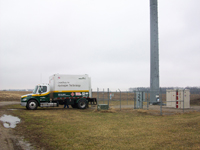|
Backup power is a vital consideration for the resilience of a TETRA network. Sandra Saathoff considers fuel cells as a sustainable alternative to diesel generators Whether a TETRA network is being used for ‘blue light’ emergency or first responder personnel or to enhance general communication within a geographic locale, the robust and resilient nature of the network is its primary attribute. Recent natural disasters, as well as concerns about national security, are a dramatic demonstration of the need to further improve the reliability and availability of global communication infrastructures. One can have the most highly resilient switch network and network management, but in order to have a truly resilient network, the power behind all of this advanced equipment must also provide reliability and resilience. One tool in the quest for ever-increasing reliability in power is the fuel cell. Fuel cells have been commercially available to communication networks for a decade, with a number of suppliers providing products globally. Within early adopters, fuel cell usage has progressed from early trials to larger rollouts providing critical backup power to several hundred sites in a single network. Globally, fuel cell adoption numbers several thousand installations. Airwave, currently the world’s largest TETRA network, with 300 000 users, accounts for 10 per cent of the global TETRA user base. They have been using a small number of fuel cells within their network for over a year. Gary Orman, Airwave’s head of safety and environment, commented: “For Airwave both operational excellence and sustainability are of utmost importance to us, and we see the use of hydrogen fuel cells becoming more prevalent in the future to enable us to meet our business objectives in both these areas. Providing high reliability standby power whilst reducing emissions and waste can only be a win-win situation for us.” Fuel cell power solutionsBefore discussing how a fuel cell complements a TETRA network, we first must understand exactly how it does what it does. A fuel cell is a DC power generator that converts the chemical energy of a fuel (hydrogen, natural gas, methane, methanol, etc.) and an oxidant (air or oxygen) directly into electricity. While there are a number of fuel cell technologies available, the most common and practical technology for small to medium-sized standby power is the proton exchange membrane (PEM) fuel cell which generates electricity through an electrochemical reaction using hydrogen and oxygen. This process happens without combustion. A fuel cell operates electrochemically through the use of an electrolyte, just like a battery, but it does not run down or require recharging. It is similar to a generator in that it operates as long as the fuel is supplied; but unlike an internal combustion generator, it is simple, quiet, and clean with few moving parts. Because fuel cell systems are load-following, fuel consumption depends on the load, and equipment operating at relatively low loads can see a significant extension of runtime when powered by this technology. Criteria for selecting a fuel cell backup system for a specific application include power requirements, frequency and duration of outages, response time to the site, environmental restrictions and serviceability requirements. Fuel cells can and are being used as the sole backup power solution in many critical applications; however, they can also be used as an added layer of protection for a site using incumbent solutions. This concept is analogous to a layered network security architecture where each layer of security, e.g. firewalls, intrusion detection devices, etc., add to the overall network protection. Fuel cells offer rack-mounting options within an equipment shelter as well as environmentally-hardened outdoor cabinets for flexibility to meet network design parameters. Most fuel cells being used for backup power today range from 50 watts to approximately 20 kilowatts. Based on technology available today, customer sites can be provisioned with fuel for hundreds of hours of runtime. Refuelling allows the system to run continuously as long as needed during extended outages. For sites with these relatively low power loads and outages lasting from hours to days, fuel cells can be the backup power source of choice. Fuelling optionsIntrinsic to fuel cells is the need for fuel in order to operate. PEM fuel cells use hydrogen as the fuel to supply electricity and there are a number of options for fuelling. Traditionally, fuel cells have used hydrogen cylinders to store fuel (packaged gas). The refuelling of hydrogen cylinders is accomplished by a vehicle transporting full cylinders to the site and exchanging them for the empties. Though somewhat labour-intensive, for many locations this remains the option of choice.
|

